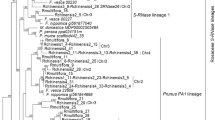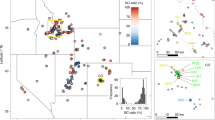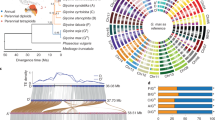Abstract
Allelic diversity at the self-incompatibility (S-) locus in the ground cherry, Physalis crassifolia (Solanaceae), was surveyed in a natural population occurring in Deep Canyon, CA, using a molecular assay to determine the genotype of individual plants. A total of 28 different S-alleles were identified and sequenced from a sample of 22 plants. All plants examined were heterozygous, as expected under gametophytic self-incompatibility (GSI). The estimated number of alleles in this population is 43–44, comparable to allelic diversity reported for other species, as determined by the standard diallel crossing method. Allele frequencies in the sample deviated from the expectation of equal frequency under GSI; it is suggested that this deviation may result from sampling of related individuals. Molecular analysis of genotypes within single pollen donor families indicates that, for all alleles examined, segregation is consistent with predictions for single-locus GSI. The implications of a reliable and efficient molecular assay for determining the S-genotype of plants are discussed.
Similar content being viewed by others
Article PDF
References
Ai, Y, Singh, A, Coleman, C E, Ioerger, T R, Kheyrpour, A, and Kao, T-H. 1990. Self-incompatibility in Petunia inflata: isolation and characterization of cDNAs encoding three S-allele-associated proteins. Sex Plant Repro, 3, 130–138.
Broothaerts, W, Janssens, G A, Proost, P, and Broekaert, W F. 1995. cDNA cloning and molecular analysis of two self-incompatibility alleles from apple. Plant Mol Biol, 27, 499–511.
Campbell, J M, and Lawrence, M J. 1981. The population genetics of the self-incompatibility polymorphism in Papaver rhoeas. II. The number and frequency of S-alleles in a natural population (R106. Heredity, 46, 81–90.
Emerson, S. 1938. The genetics of self-incompatibility in Oenothera organensis. Evolution, 23, 190–202.
Emerson, S. 1939. A preliminary survey of the Oenothera organensis population. Evolution, 24, 524–537.
Ioerger, T R, Gohlke, J R, Xu, B, and Kao, T-H. 1991. Primary structural features of the self-incompatibility protein in Solanaceae. Sex Plant Repro, 4, 81–87.
Jost, W, Bak, H, Glund, K, Terpstra, P, and Beinteme, J J. 1991. Amino acid sequence of an extracellular, phosphate-starvation-induced ribonuclease from cultured tomato (Lycopersicon esculentum) cells. Eur J Biochem, 198, 1–6.
Kheyr-Pour, A, Bintrim, S B, Ioerger, T R, Remy, R, Hammond, S A, and Kao, T-H. 1990. Sequence diversity of pistil S-proteins associated with gametophytic self-incompatibility in Nicotiana alata. Sex Plant Repro, 3, 88–97.
Lawrence, M J. 1975. The genetics of self-incompatibility in Papaver rhoeas. Proc R Soc B, 188, 275–285.
Lawrence, M J, and O'Donnell, S. 1981. The population genetics of the self-incompatibility polymorphism in Papaver rhoeas. III. The number and frequency of S-alleles in two further natural populations (R102 and R104. Heredity, 47, 53–61.
Levin, D A. 1993. S-gene polymorphism in Phlox drummondii. Heredity, 71, 193–198.
Mantel, N. 1974. Approaches to a health research occupancy problem. Biometrics, 30, 355–362.
O'Donnell, S, and Lawrence, M J. 1984. The population genetics of the self-incompatibility polymorphism in Papaver rhoeas IV. The estimation of the number of alleles in a population. Heredity, 53, 495–507.
Ockendon, D J. 1974. Distribution of self-incompatibility alleles and breeding structure of open-pollinated cultivars of Brussels sprouts. Heredity, 33, 159–171.
Pandey, K K. 1957. Genetics of self-incompatibility in Physalis ixocarpa Brot. -a new system. Am J Bot, 44, 879–887.
Paxman, G J. 1963. The maximum likelihood estimation of the number of self-sterility alleles in a population. Genetics, 48, 1029–1032.
Richman, A D, Kao, T-H, Schaeffer, S W, and Uyenoyama, M K. 1995. S-allele sequence diversity in natural populations of Solanum carolinense. (Horsenettle). Heredity, 75, 405–415.
Royo, J, Kowyama, Y, and Clarke, A E. 1994. Cloning and nucleotide sequence of two S-RNases from Lycopersicon peruvianum (L.) Mill. Pl Physiol, 105, 751–752.
Takahata, N. 1993a. Allelic genealogy and human evolution. Mol Biol Evol, 10, 2–22.
Takahata, N. 1993b. Evolutionary genetics of human paleo-populations. In: Takahata, N. and Clark, A. G. (eds) Mechanisms of Molecular Evolution, pp. 1–21. Sinauer Associates, Sunderland, MA.
Thompson, J D, Higgins, D G, and Gibson, T J. 1994. CLUSTAL w: improving the sensitivity of progressive multiple sequence alignment through sequence weighting, position-specific gap penalties and weight matrix choice. Nucl Acids Res, 22, 4673–4680.
Vekemans, X, and Slatkin, M. 1994. Gene and allelic genealogies at a gametophytic self-incompatibility locus. Genetics, 137, 1157–1165.
Wright, S. 1960. On the number of self-incompatibility alleles maintained in equilibrium by a given mutation rate in population of a given size: a reexamination. Biometrics, 16, 61–85.
Xu, B, Mu, J, Nevins, D L, Grun, P, and Kao, T-H. 1990. Cloning and sequencing of cDNAs encoding two self-incompatibility associated proteins in Solanum chacoense. Mol Gen Genet, 224 341–346.
Yokoyama, S, and Hetherington, L E. 1982. The expected number of self-incompatibility alleles in finite plant populations. Heredity, 48, 299–303.
Author information
Authors and Affiliations
Rights and permissions
About this article
Cite this article
Richman, A., Uyenoyama, M. & Kohn, J. S-allele diversity in a natural population of Physalis crassifolia (Solanaceae) (ground cherry) assessed by RT-PCR. Heredity 76, 497–505 (1996). https://doi.org/10.1038/hdy.1996.72
Received:
Issue date:
DOI: https://doi.org/10.1038/hdy.1996.72
Keywords
This article is cited by
-
Development of PCR-based markers for the identification of the S-RNase alleles in wild potato species
Euphytica (2012)
-
Functional gametophytic self-incompatibility in a peripheral population of Solanum peruvianum (Solanaceae)
Heredity (2011)
-
The genetic location of the self-incompatibility locus in white clover (Trifolium repens L.)
Theoretical and Applied Genetics (2010)
-
Molecular and genetic characterization of novel S-RNases from a natural population of Nicotiana alata
Plant Cell Reports (2010)
-
Population size, self-incompatibility and genetic rescue in diploid and tetraploid races of Rutidosis leptorrhynchoides (Asteraceae)
Heredity (2008)



